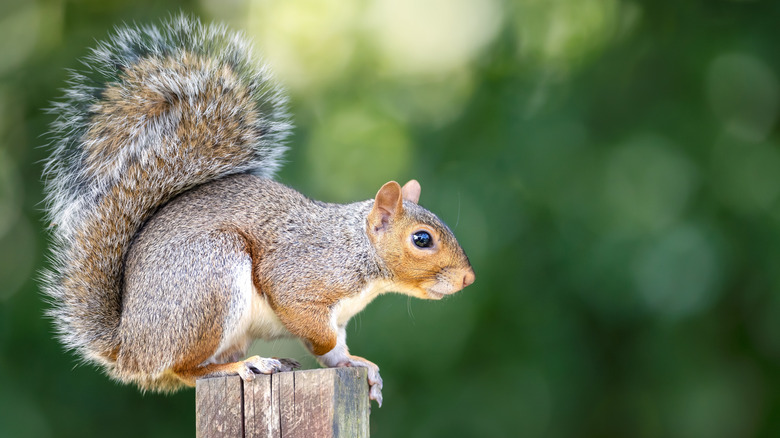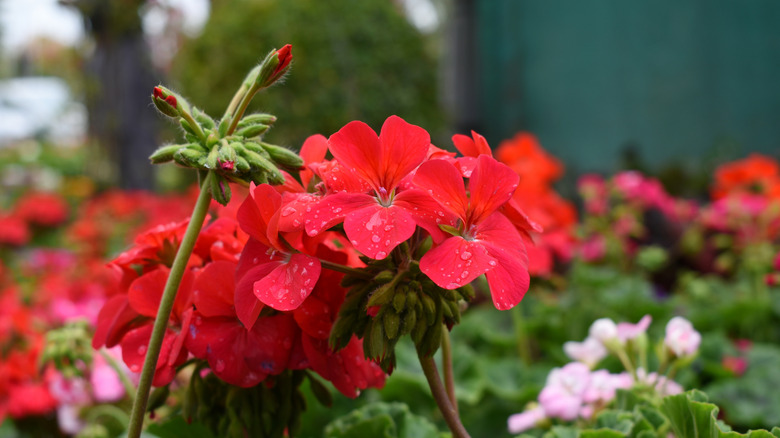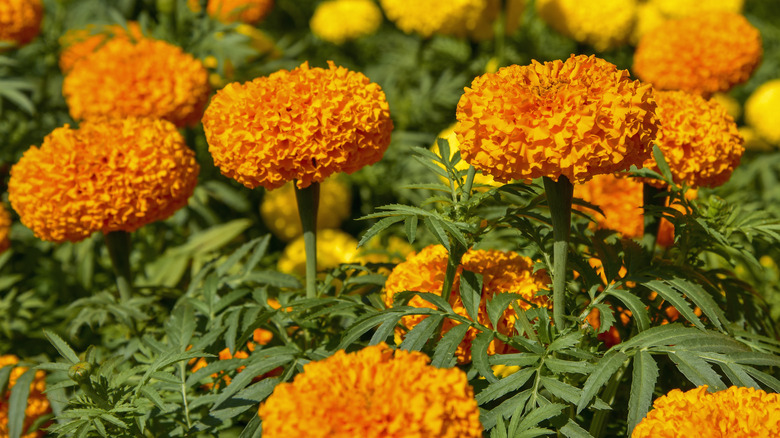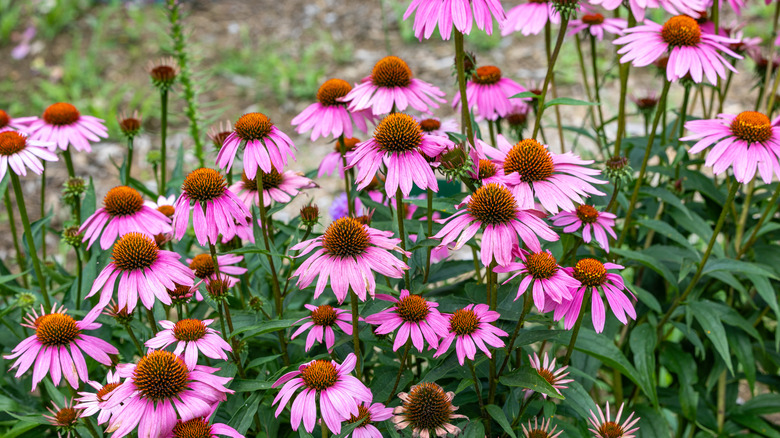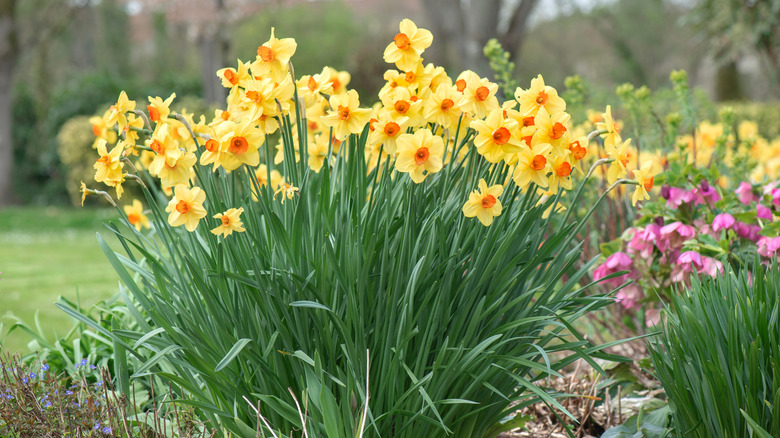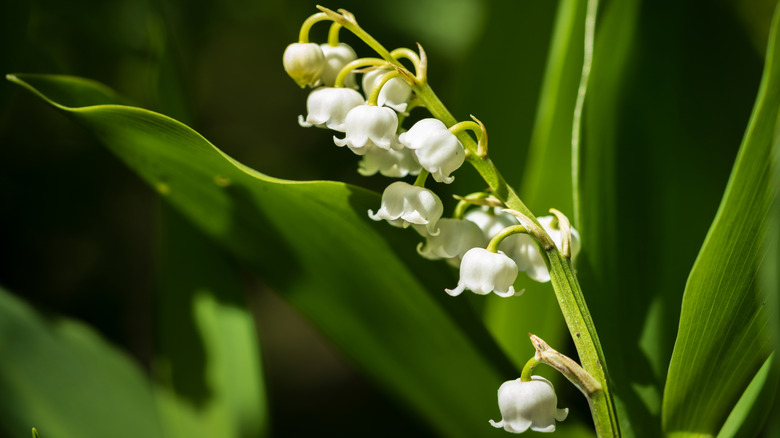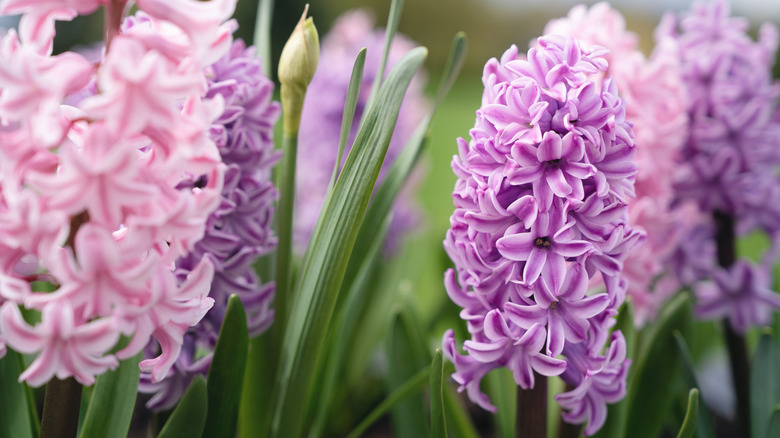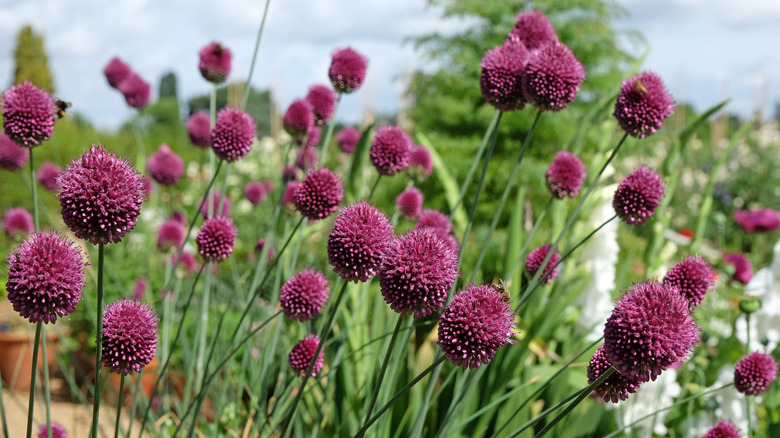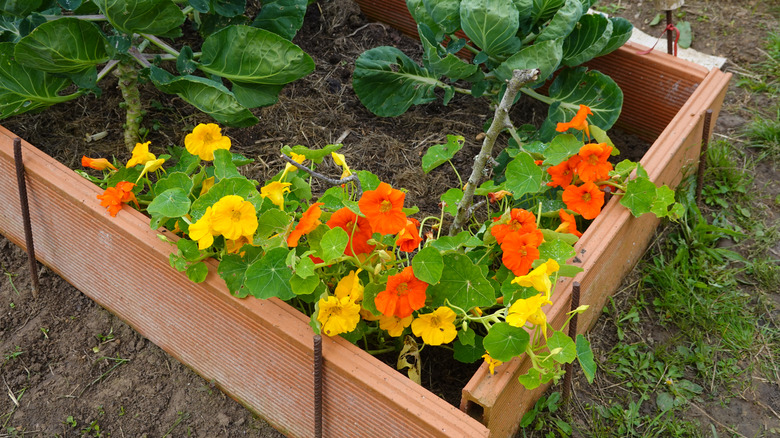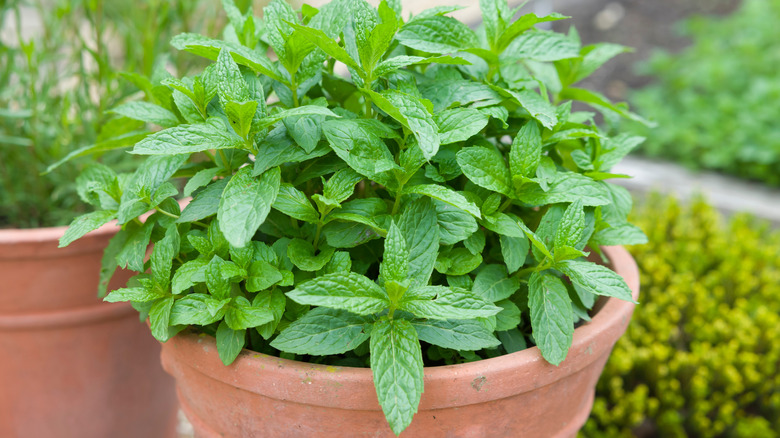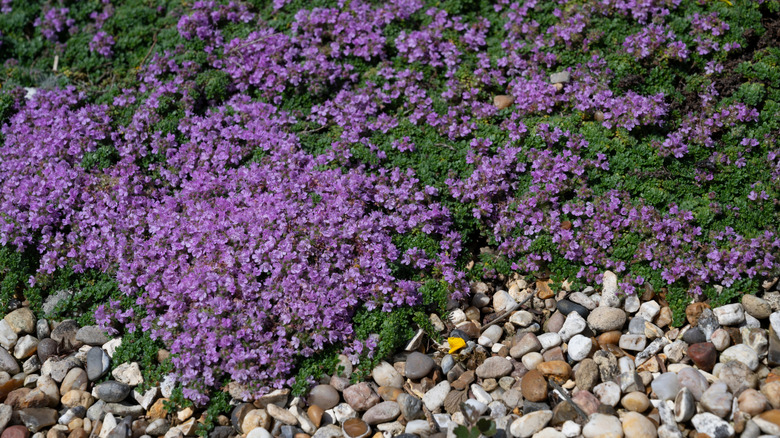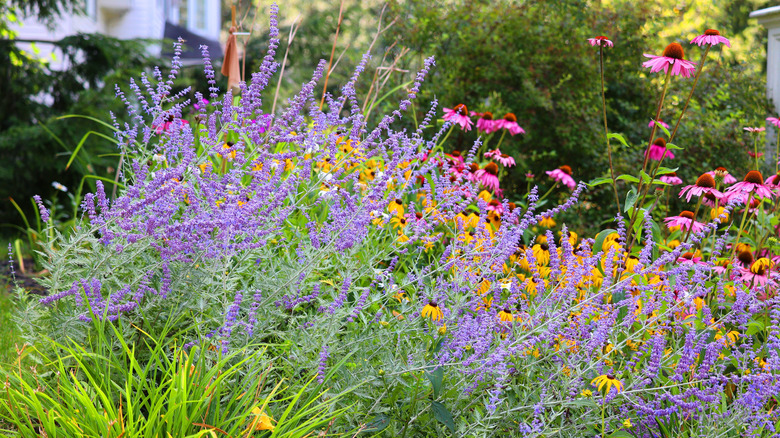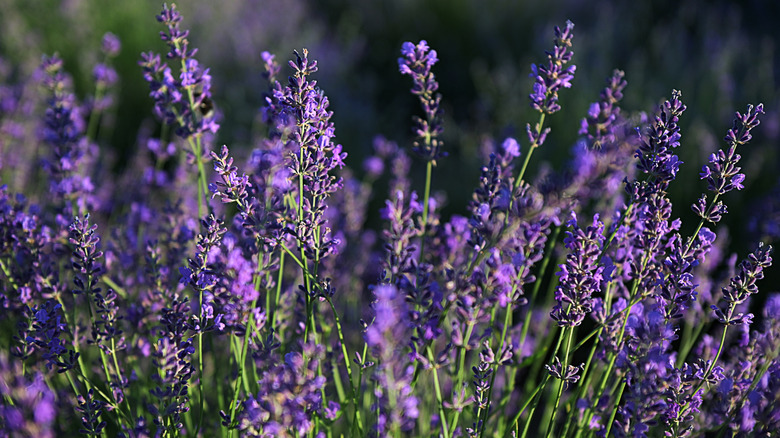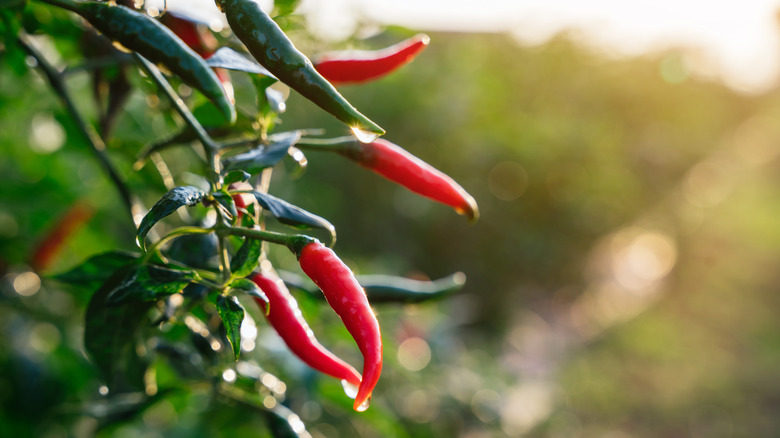Deter Squirrels From Your Yard With Plants They Can't Stand
As many gardeners know, you don't have to intentionally attract squirrels to your yard to end up with a daily crew of bushy-tailed visitors. Many of the most common gardening plants also taste delicious to squirrels, but luckily, there are plenty that they can't stand, including daffodils, hyacinths, marigolds, mint, thyme, and more.
Completely keeping squirrels away is no small feat. They're one of the most frequently sighted backyard critters, and while they famously eat lots of nuts, they will also eat a wide range of other foods, such as berries, fruits, and flower buds. Unfortunately for your garden, most fruits and veggies are on the table, as well as many seeds and seedlings. As squirrels forage for food, they make quite a mess, from upturned plant pots to holes in the ground to half-eaten plants (not to mention emptying your bird feeders). Physical barriers are generally the most effective at keeping squirrels at bay, but fencing needs to be buried to prevent digging, and this can be unsightly and pricey.
Unless you're a big fan of the "wrapping every plant in chicken wire" look, it's helpful to know which plants squirrels typically leave alone so you can incorporate them into your garden. Typically, plants with strong smells, spikes, tough leaves, or milky sap are unlikely to appeal to critters like squirrels. Of course, toxic plants are also a definite deterrent. Not only can you freely plant these without worrying about squirrel damage, but they may also help protect your other plants, too. It's best to rotate different selections of these plants in and out of your yard, because squirrels are mighty adaptable.
Geraniums
Geraniums (Pelargonium) have a strong smell that humans tend to love, but squirrels hate. Plus, they have fuzzy stems and leaves, which are less appealing to a squirrel than a smooth plant. These flowers bloom for a long time and are commonly used as annual bedding plants, though they can be overwintered indoors in a sunny window. Geraniums are toxic to dogs and cats.
Marigolds
Marigolds (Tagetes spp.) are another long-blooming annual with a strong odor that squirrels dislike. They also repel a range of other pests, like aphids, whiteflies, cucumber beetles, and nematodes. Marigolds thrive in the summer heat; just place them in a sunny spot and offer consistent water. Deadheading will help prolong the blooming season even more.
Coneflowers
Coneflowers are a group of eight or nine species of plant in the Echinacea genus. They are native to the eastern and central US and are generally resistant to wildlife damage, though one in particular has been found to draw little attention from squirrels: purple coneflower (Echinacea angustifolia). This flower resists deer as well, while providing food to butterflies and goldfinches. It is hardy in USDA Hardiness Zones 3 to 8, grows well in full sun to partial shade, and is drought-tolerant.
Daffodils
Aside from tulips and crocuses, squirrels dislike most bulbs. One option to consider is the ever-popular daffodil (Narcissus spp.) — they contain lycorine as well as oxalic acid, both of which are toxic to squirrels, and the smell is also off-putting to them. There are thousands of daffodil varieties to choose from. Plant the bulbs in the fall to enjoy flowers in the late winter and early spring. They prefer full sun, but will tolerate partial shade. Keep in mind that daffodils are also toxic to pets and humans. They are hardy in USDA Zones 3 to 9.
Lily of the valley
Lily of the valley (Convallaria majalis) is beautiful and fragrant with small, bell-shaped flowers. It's popular as a ground cover for shady areas, though it can spread aggressively. As for squirrels, lily of the valley is anything but a tasty snack. Like the daffodil, this is another bulb that is toxic to squirrels, but also pets and people, so it should be planted with care. All parts of the plant are toxic. Lily of the valley is hardy in Zones 3 to 7.
Hyacinths
Squirrels are not a fan of hyacinths' (Hyacinthus spp.) strong signature scent, and they'd regret it if they did venture a taste. These flowers contain oxalic acid in the leaves, flowers, and most of all, in the bulbs, meaning they are toxic to squirrels as well as pets and humans. You should wear gloves to avoid skin irritation while planting them in the fall, but the early spring flowers are a worthwhile payoff. Hyacinths are cold-hardy in Zones 3 to 9 and require a period of cold to bloom.
Alliums
The Allium plant family includes garlic, onion, shallots, and other common foods known for their pungent scent, so it's unsurprising that squirrels are not a fan. If you'd rather add beauty to your garden, consider ornamental onions (some of which are edible, too). There are more than 700 allium species to choose from, featuring vibrant globe-shaped clusters of flowers. Most species require full sun and bloom in the early summer, with a hardiness range of Zones 3 to 8. Alliums are pest-resistant in other ways while attracting beneficial pollinators. They can cause stomach upset in dogs and cats.
Nasturtiums
Nasturtiums (Tropaeolum majus) also have a pungent smell that squirrels don't usually go for. They are usually grown as an annual, though they're hardy in Zones 9 to 11, and there are both trailing and compact varieties to choose from. With their edible flowers and leaves, nasturtiums have a similar sharp, almost spicy taste to watercress. They flower for a long time — until the first frost arrives.
Mint
Many herbs have a strong scent that discourages squirrels from taking a bite, and mint (Mentha spp.) is a top contender. It's incredibly easy to grow, so much so that it can spread too aggressively, so it's best to plant it in a pot . There are tons of types of mint to choose from with different flavors, and it's a highly adaptable plant that can grow in both full sun and partial shade. Mint is hardy in Zones 3 to 11. It is slightly toxic to dogs if they consume a large amount.
Thyme
Thyme (Thymus spp.) is another strong-smelling herb that squirrels usually ignore. The most popular thyme is called common thyme (Thymus vulgaris) and is often used in cooking, but there are also many different kinds, including creeping species that make great ground covers. Thyme requires full sun and dry, well-draining soil; it doesn't need much watering or maintenance. It resists deer and rabbits in addition to squirrels and is hardy in Zones 5 to 9.
Russian sage
Russian sage (Perovskia atriplicifolia) is often confused with sage or lavender, but is a different plant entirely. Its foliage smells too strong for squirrels to bother with; the same goes for deer and rabbits. It's adaptable to a wide range of conditions once it gets established, though it prefers full sun. Just make sure that the soil is well-draining. Russian sage is hardy in Zones 4 to 9.
Lavender
One last fragrant herb to consider for a squirrel-proof garden is lavender. There are three main types: Spanish lavender (Lavandula stoechas), English lavender (Lavandula angustifolia), and English lavender hybrids (Lavandula x intermedia), but there are more than 40 other kinds, too. Most are hardy in Zones 5 to 9, while Spanish lavender is hardy in Zones 7 to 9. Lavender grows best in full sun and planted in well-draining and poor soil.
Hot peppers
Peppers are unlikely to be touched by even the bravest of squirrels. Hot peppers (Capsicum annuum) can only be grown as perennials in Zones 9 to 11, but you can also cultivate them as annuals or bring them indoors during the winter. They require full sun, warm weather, and moist, well-draining soil. Squirrels hate pepper so much that you can also sprinkle this spice to keep squirrels away from other plants. Either sprinkle plants with cayenne or spray on a mixture of hot sauce, water, and dish soap. Just make sure to re-apply if it rains or snows.
